Shala K. Howell's Blog, page 3
March 2, 2023
Nonfiction project update
I didn’t actually expect it to happen.
But it did anyway.
Last month, a troop of drama students came in to show me their latest props project, paper mache hamburgers, complete with a side of chips. When they asked if we would be willing to display them in the library, naturally I said yes.
 Prop hamburgers, made by the drama class, hard at work drawing a steady stream of visitors to our nonfiction section. (Photo: Shala Howell)
Prop hamburgers, made by the drama class, hard at work drawing a steady stream of visitors to our nonfiction section. (Photo: Shala Howell)They look absolutely fabulous in their new home above our arts and crafts nonfiction books.
As far as I can tell, our project to boost nonfiction circulation by making the nonfiction section feel more browse-able seems to be working.
Last year, about 1 in every 10 books checked out from our library was a nonfiction book. So far this year, it looks to be closer to 1 in 5.
Related links:
Making our nonfiction more accessible (Caterpickles)Revamping our fiction shelves (Caterpickles)December 25, 2022
Where did the day go?
Happy Holidays, y’all!
Thank you for spending another year reading Caterpickles.
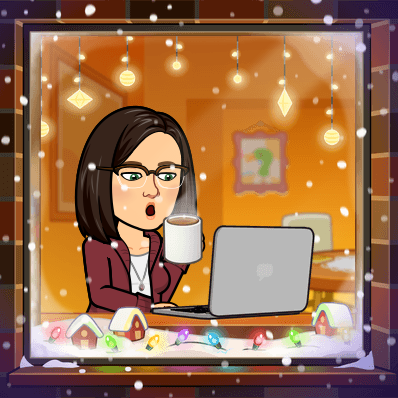 We are home this year, so quiet day for us. Little bit of cooking, some cleaning, gift opening, cat napping (literally, the cat napped), and of course reading broke out.
We are home this year, so quiet day for us. Little bit of cooking, some cleaning, gift opening, cat napping (literally, the cat napped), and of course reading broke out.
November 23, 2022
It’s fall break and the turkeys are gathering…
We went for a walk around the nature trail at Filoli Historic House and Gardens a week or so ago, and ran into an enormous-to-us gang of turkeys. Much of the rest of our walk was taken up by speculating on collective nouns for turkey swarms – are they a flock, a gaggle, a gobble, a posse, or a herd?
 Flock-gaggle-posse-rafter of turkeys at Filoli Historic House & Gardens. (Photo: Shala Howell)
Flock-gaggle-posse-rafter of turkeys at Filoli Historic House & Gardens. (Photo: Shala Howell)Whatever word you use to describe your turkey collective, I hope you have some time to relax and enjoy the company of your favorite people this week.
Related links:
My care-free no-fuss Thanksgiving (Caterpickles)Are there European turkeys? (Caterpickles)Why do we eat Turkey at Thanksgiving? (Caterpickles)October 16, 2022
Making our nonfiction more accessible
Good morning!
Grad school is having a “catch up on your reading week,” and I thought I’d use this pause between catching up on my reading and getting started on the two papers a week I have due between now and December 6, to report on how it’s going nonfiction-wise at my middle school library.
It’s been a busy month and a half for us. Total circulation (fiction and nonfiction) in September 2022 continues to enjoy a healthy 32% increase over the same period last year. Our work increasing the accessibility of our nonfiction section continues to pay off. In September 2022, nonfiction circulation was up 129.27% when compared to the same period last year. Even better, on average 42% of those nonfiction books are being checked out for the first time in more than two years.
At some point this month, I came across a quote somewhere-maybe in one of my grad school readings, maybe on disability Twitter-to the effect of “accessibility issues cloak demand.”
In other words, if your service is hard to navigate, you will never realize how much actual demand there is for it. Folks who need it and who would otherwise use it will give up in frustration or simply go elsewhere. I have been thinking about that a lot this month, as I watch the students interact with our nonfiction collection, and as the returned nonfiction books overload my shelving carts.
It’s caused me to shift my view of this project. When we started working on our nonfiction section, I thought of it in terms of increasing demand by making the nonfiction section more browse-able for casual users. But after observing the results over the past two months, I think what we’re actually doing is breaking down barriers to using nonfiction to reveal the demand that already exists.
Why the huge jump in nonfiction circulation this month?It was not all me.
One of our teachers brought all of her classes in with the express requirement that they browse our renovated nonfiction section and check out at least one book. Teacher support is essential, and it gave our Teacher Librarian a chance to remind several classes’ worth of students how to navigate our nonfiction section. Which reminds me, I need to send that teacher a thank-you note.
My pop-up display this month, themed around our annual Spooky Art & Writing Contest, also moved a ton of books. Many more books than my Surviving Middle School display last month, truth be told. In observing how the kids interacted with the Surviving Middle School display, I noticed that they tended to take the books on the table and leave the books in the bookcase (for the most part). So I made some changes for the Spooky Contest display.
 For my Spooky Contest display, I used a combination of graphic novels, short fiction, how-to books on writing and drawing, as well as various books from our nonfiction section on ghosts, haunted houses, mummies, monsters, and spooky folk tales from around the world. The display also included the contest rules, past winning entries, as well as tip-sheets I created last year for writers and artists based on past years of judging the contest. (Photo: Shala Howell)
For my Spooky Contest display, I used a combination of graphic novels, short fiction, how-to books on writing and drawing, as well as various books from our nonfiction section on ghosts, haunted houses, mummies, monsters, and spooky folk tales from around the world. The display also included the contest rules, past winning entries, as well as tip-sheets I created last year for writers and artists based on past years of judging the contest. (Photo: Shala Howell)(Note: This post contains affiliate links to Bookshop.org. If you use them to buy books from Bookshop.org, I’ll earn a small commission. Read more about why I decided to use affiliate links here.)
This display moved a ton of books. We were constantly refilling gaps in it throughout the day. Nonfiction-wise, the drawing books were extremely popular, as were books like Killer Koalas from Outer Space, Fearsome Creatures from the Lumberwoods, Ask the Bones, and the various monster books. We’re going to continue using this style, with a few tweaks to improve neatness, going forward.
Of course, it helped tremendously that the display was themed around a topic that the students themselves were interested in. In short, a powerful tool to be used when a timely and student-driven topic comes up.
What other changes did we make around the library this month?I did a few other small things this month. They aren’t having quite the same impact as the displays or teacher support, of course, but they also didn’t require nearly as much effort.
Asking the students for help updating our nonfiction collectionOur nonfiction collection is the product of steady accumulation over two decades. In other words, there are a lot of old books lurking in there. My Teacher Librarian is weeding the 300s and 500s this year, but that leaves eight other Dewey Decimal sections unattended. The odds that a student will come across something that is out of date and/or otherwise needs to be replaced are high.
So I posted little signs around the nonfiction section inviting students to let me know when they find a book on a topic of interest to them that is too old to be useful. So far, students have come to me with requests to update our gardening books and to find new nonfiction options on immigration law for teens.
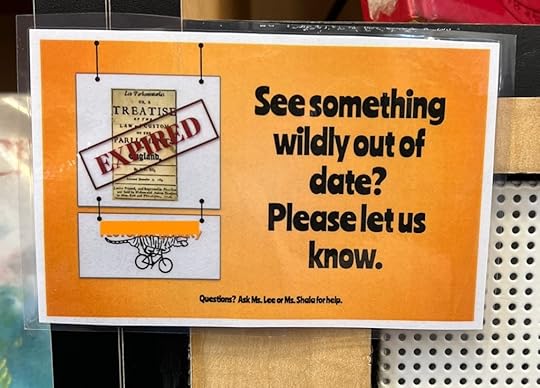 Folks on Library Twitter may recognize the basic design of this sign, as it is based on @ShackLibrary’s daily social media updates for their library patrons. (Design: @ShackLibrary; This ad: Shala Howell, created using Google Slides). Little reminders in popular places
Folks on Library Twitter may recognize the basic design of this sign, as it is based on @ShackLibrary’s daily social media updates for their library patrons. (Design: @ShackLibrary; This ad: Shala Howell, created using Google Slides). Little reminders in popular placesI’m also experimenting with placing little reminders of our nonfiction collection in popular places. For example, we have a very intense set of chess players this year. It just so happens, we have several books on learning chess in our collection. I took one of them, and placed it on display next to the chess games.
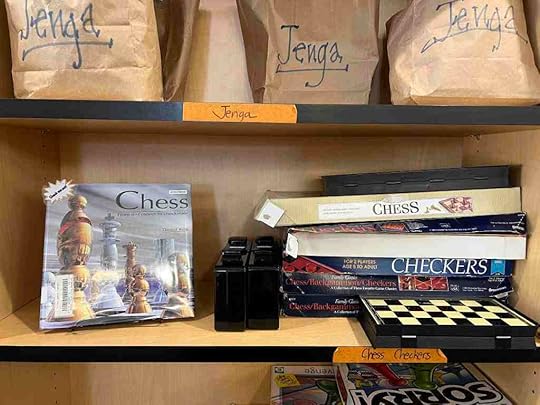 The little star on it says “Check me out!” (Photo: Shala Howell)
The little star on it says “Check me out!” (Photo: Shala Howell)When students take the book down to use during lunch, it exposes this little sign.
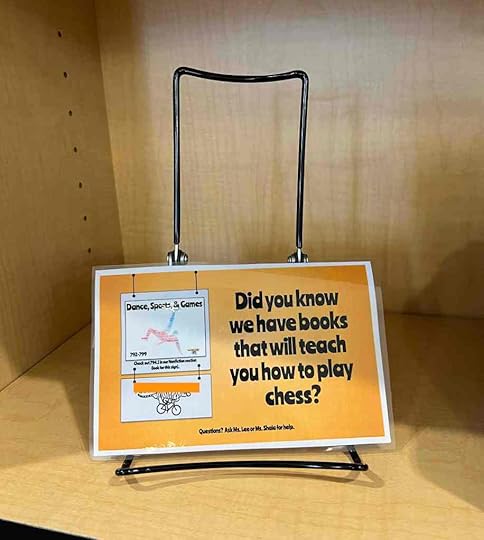 Another nonfiction ad created using @ShackLibrary’s design. This one includes a small image of my Dance, Sports, & Games sign as a visual clue to where the students will find the Chess books. (Photo: Shala Howell, with deep thanks to @ShackLibrary. If you aren’t following them on Twitter, you are missing out on some powerful ideas for running a school library and some great communications-friendly graphic design.)What’s coming up next month?
Another nonfiction ad created using @ShackLibrary’s design. This one includes a small image of my Dance, Sports, & Games sign as a visual clue to where the students will find the Chess books. (Photo: Shala Howell, with deep thanks to @ShackLibrary. If you aren’t following them on Twitter, you are missing out on some powerful ideas for running a school library and some great communications-friendly graphic design.)What’s coming up next month? Great things, friend, great things.
Ok. Truthfully, I don’t know yet, but I’ll report back (probably in December once the semester is over), to let you know what happened.
Thank you for spending part of your day reading Caterpickles. If you work in a library or simply read nonfiction, I would love to hear your thoughts on other ways we can make our nonfiction collection more accessible to students. As always, if you see an idea here that you would like to try in your library, please feel free. If you have time, I’d love to hear how it worked.
Related Links:
Experiment #7264532: “So You’re in Middle School, Now What?“ Pop-up Display (Caterpickles)Making our nonfiction section more browse-able, Part IV (Caterpickles)
September 6, 2022
It’s hot
Like really hot. Stay safe out there, folks.
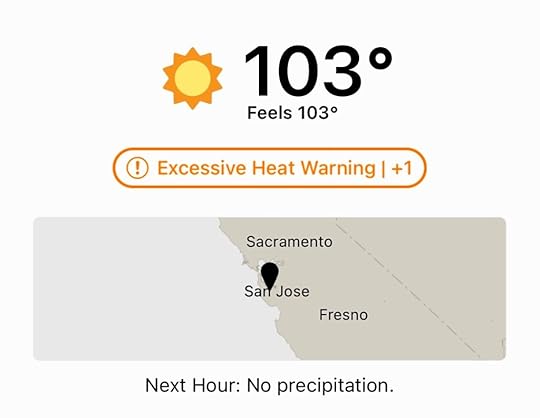 Mediterranean climate, eh? (Weather source: Dark Sky)
Mediterranean climate, eh? (Weather source: Dark Sky)
August 31, 2022
Experiment #7264532: “So You’re in Middle School, Now What?“ Pop-up Display
Not much time today between school, grad school, and mandatory school shooter response trainings, but I’m super pleased with how my pop-up display on middle school themed books turned out and wanted to share a few pictures.
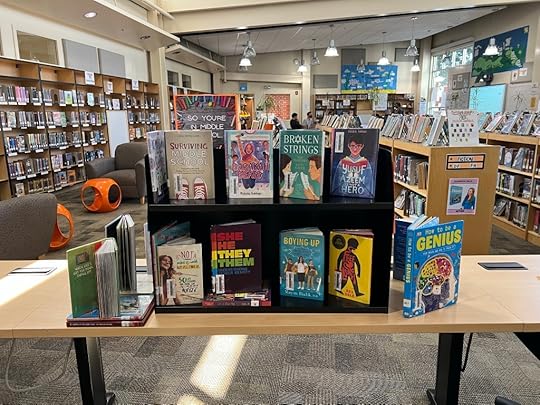 We found a tiered display stand in the storage room, so of course I’m using it to display a mix of fiction, nonfiction, and graphic novel books on navigating middle school. (Photo: Shala Howell)
We found a tiered display stand in the storage room, so of course I’m using it to display a mix of fiction, nonfiction, and graphic novel books on navigating middle school. (Photo: Shala Howell) The back of the stand is basically a giant black wall, so I used Canva to make ads for the different type of books folks will find in my display. Oh and added another line of books so folks would have stuff to look at no matter where they are standing. (Photo: Shala Howell)
The back of the stand is basically a giant black wall, so I used Canva to make ads for the different type of books folks will find in my display. Oh and added another line of books so folks would have stuff to look at no matter where they are standing. (Photo: Shala Howell) Graphic novels are clustered on one end of the display, but otherwise the books are all jumbled together. I am unconvinced that this will work, but I didn’t have enough display stands to segregate by type and you work with what you have not what you wish you had. (Photo: Shala Howell)
Graphic novels are clustered on one end of the display, but otherwise the books are all jumbled together. I am unconvinced that this will work, but I didn’t have enough display stands to segregate by type and you work with what you have not what you wish you had. (Photo: Shala Howell)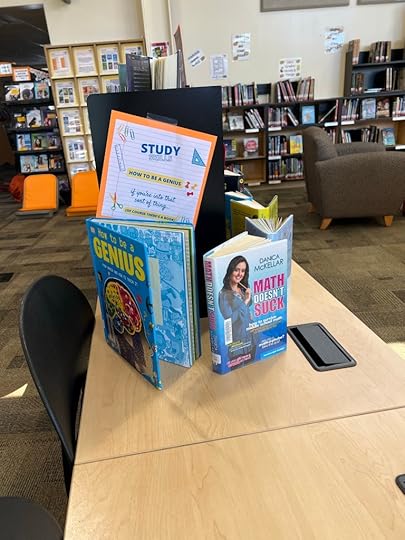 I am going to need to straighten that sign when I get in to work today. I don’t like it catty-wompered like that. (Photo: Shala Howell)
I am going to need to straighten that sign when I get in to work today. I don’t like it catty-wompered like that. (Photo: Shala Howell)Anyway that’s what I did yesterday to move some books. I have a cart of nonfiction books to refill those nonfiction gaps but we have so many fiction and graphic novels set in middle school that I’m just going to grab whatever’s on the shelves at the moment to plug holes as they happen.
Related Links:
Making our nonfiction section more browse-able: Part IV (Caterpickles)August 8, 2022
Making our nonfiction more browse-able: Part IV
One week of grad school and my word cloud nonfiction sign problem is solved.
The Problem: Our old signs were boring and no one used themAs you may remember from Part II in this series, our original nonfiction signs were boring and no one looked at them.
 Our old signs were placed high above the stacks, where the glare from the lights often made them hard to read. (Photo: Shala Howell)My first attempt to fix it: Handmade word clouds
Our old signs were placed high above the stacks, where the glare from the lights often made them hard to read. (Photo: Shala Howell)My first attempt to fix it: Handmade word cloudsLast spring, I experimented with changing out our standard Nonfiction signs with word cloud-based signs. My hope for these word-cloud based signs was to make it easier for students to find books they were interested in, without having to resort to using one of the library computers.
My new Word Cloud signs got attention, because a) they were new; b) I was careful to include the topics the students themselves told me they were interested in; and c) because I made sure that each sign had a few odd phrases on it to make it worth reading.
 My new signs, in their beta run last spring. (Photo: Shala Howell)
My new signs, in their beta run last spring. (Photo: Shala Howell)The problem with my new signs was that they took hours to make. I rolled them out as I completed them, and the new signs did appear to increase traffic. But as the school year came to a close, I was forced to choose how to spend the rest of my time. I could either:
rearrange the nonfiction section to fill gaps, eliminate the overcrowded shelves, and add more forward-facing books *or* make the rest of the signs.In the end, I decided that rebalancing the nonfiction section would have a better chance of boosting circulation, so I chose to do that instead.
Grad school enters the chatOn the first day of grad school, our instructor asked us to introduce ourselves in an online discussion group by making a video, writing a little bio, making an infographic in Canva, or using WordArt.com to create a word cloud that captured a few things about ourselves that we were willing to share with the class. You can probably guess what I chose.
 A word cloud in the shape of an owl, listing some of my interests. (Image: WordArt/Shala Howell)
A word cloud in the shape of an owl, listing some of my interests. (Image: WordArt/Shala Howell)WordArt is frankly awesome, and now that I’ve used it, I’m more than a little embarrassed that I didn’t realize it existed last spring. This owl took maybe five minutes to generate, and I spent most of that time choosing a shape and picking words.
You can probably guess what happened nextLast Friday was my first work day of the new school year, and of course, I spent part of the day using WordArt to make themed word clouds for my new nonfiction signs.
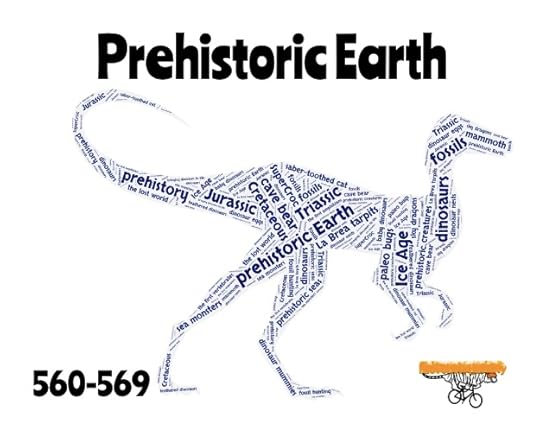 My new sign for the Nonfiction section containing all the dinosaur books. (Image: Shala Howell. I used WordArt to create the WordCloud and Google Slides to make the sign itself.)
My new sign for the Nonfiction section containing all the dinosaur books. (Image: Shala Howell. I used WordArt to create the WordCloud and Google Slides to make the sign itself.)I am very excited about these signs. Our old signage system had 10 signs, one for each century in the Dewey Decimal system. They were generic because they had to be.
My new signage system includes 26 signs. I have made anywhere from 1-6 signs per century, depending on how large our collection in that area. This gave me a lot of flexibility in highlighting where popular books are. Wherever possible, I ditched the generic terms for the Dewey Decimal centuries and replaced them with terms that related to the books contained in that particular section of the library. For example, because our 500 section sprawls out across several bookshelves and covers a wide range of topics of interest to our students, I have created signs splitting out the 500s into “Science & Math,” “Earth Sciences,” “Life Sciences – Plants,” “Life Sciences – Animals,” and “Prehistoric Earth.”
I also did my best to pick word cloud shapes that reflected the primary topic in each section. I am hoping that using the shaped clouds will make my signs more visually effective, even from across the room. With any luck, the shapes will give you a pretty good idea of what you’ll find in a given bookshelf before you’re close enough to read any words.
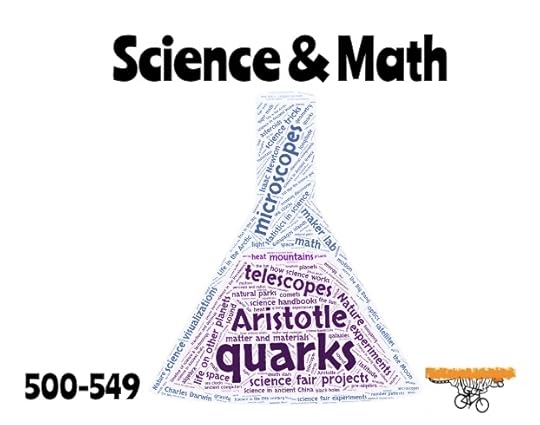 My new sign for the Science & Math section. (Image: Shala Howell. I used WordArt to create the WordCloud and Google Slides to make the sign itself.)
My new sign for the Science & Math section. (Image: Shala Howell. I used WordArt to create the WordCloud and Google Slides to make the sign itself.)Bonus: Finding shapes for these was a lot of fun.
The 920 and 921 problemOne final note: I did not create fancy word cloud signs for our Biography (920) and Biography Collection (921) books, for a few reasons. First, we have already pulled those books out of the Nonfiction half of our library and moved them into a permanent home in our teaching area, so they are easy for the students to find already.
Second, the signs marking the Biography and Biography Collection sections already matched the rest of the signs we use in the teaching area.
Finally, identifying a shape to use for a word cloud in a section that is about people can become wildly problematic very quickly. In the end, I opted to leave the signs for our Biographies and Biography Collection just the way they were.
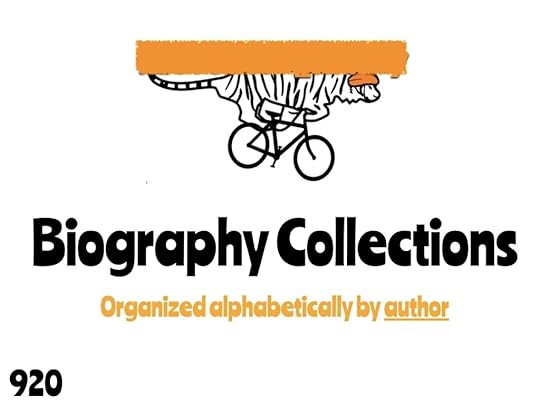 Our signs in the teaching area are very straightforward. (Image: Shala Howell, created in Google Slides)
Our signs in the teaching area are very straightforward. (Image: Shala Howell, created in Google Slides)The students start school this week, so I’ll soon find out if these changes have any effect.
Related Links:
Making our nonfiction section more browse-able: Part 1 (Caterpickles)Making our nonfiction section more browse-able: Part 2 (Caterpickles)Making our nonfiction section more browse-able: Part 3 (Caterpickles)July 29, 2022
Revamping our fiction shelves
With all this talk about our nonfiction section, it may sound like I am leaving our fiction shelves to fend for themselves.
I haven’t, I promise. It’s just that when it comes to fiction, my Teacher Librarian and I are already doing a lot. Next year’s plan is to do more of the same. In other words, to keep:
Creating looping slideshows to promote new and under-appreciated fiction books in the collectionPosting oddly specific genre-bending book recommendation lists on the wall and in my Ms. Shala Recommends binder in response to student requestsTalking to students about great books they’ve read, the books we’re reading, movies and shows based on books, and/or the kind of book they are looking for nextCreating custom book lists and/or book stacks for students who want to have more than just two or three options to choose from Creating book-themed bulletin boards Posting Staff Picks notes on the shelves similar to the ones you find in a bookstore highlighting the favorite books of librarians, admin, teachers, and even certain English classesHighlighting new arrivals by displaying them on the New Arrivals Cart and by regularly updating a bulletin board dedicated solely to promoting new booksThe main difference next year will be that I have rearranged the fiction shelves as well.
The goal: rebalance the shelves so that they are all roughly 2/3rds full. Then, make use of the new space to increase the number of forward-facing books and to make it easier for students to identify books in a series and/or our entire collection of books by popular and prolific authors like Holly Goldberg Sloan, Kelly Yang, and Neal Schusterman.
Our fiction shelves before Our fiction shelves as they appeared at the start of the 2021-2022 school year. (Photo: Shala Howell)
Our fiction shelves as they appeared at the start of the 2021-2022 school year. (Photo: Shala Howell)As you can see, last school year, most of our fiction books were stored in alphabetical order by author, spine-out for easy shelving. There were some forward-facing books in the shelves themselves, but we mostly relied on the 12 books on display on top of each stack to do the bulk of the passive book promotion.
Our fiction shelves now, sort of The rebalanced fiction shelves as they appeared just before the library closed for the summer. (Photo: Shala Howell)
The rebalanced fiction shelves as they appeared just before the library closed for the summer. (Photo: Shala Howell)Before closing the library for the summer, I rearranged all of the fiction books so that the vast majority of the shelves would have two forward-facing books on display. I also set off books in a series and/or books by the same author by themselves.
You can see this best on the bottom left hand shelf in the above picture. That shelf has been broken up into three sections. The first section contains books by various authors in alphabetical order by last name. In the middle is a collection of books by Kwame Alexander. The final section in the shelf contains the Prydain series by Lloyd Alexander, displayed in order, with the first book of the series facing out.
We still have a lot of spine-out books, but I’m hoping that breaking up the long rows of spine-out books into shorter collections of books will make it easier for students to find their next read.
(Fear not, although this photo doesn’t show them, we are still going to have the 12 books per stack displayed on top. We store them in the stacks for the summer, though, and we had already done that by the time I took this photo.)
I am excited for this new arrangement, and at the same time, worried that it will make shelving entirely too complicated for my student helpers to manage next year. I guess it will be a learning experience all around.
As always, I’ll report back. At the very least, we’ll see in next year’s End of the Year Library Report, whether all this rearranging and showcasing actually does increase our circulation numbers.
In other news, school starts next weekGrad school for me starts August 1, and my work at the middle school resumes on August 5. All of which means that I am about to hit another dry spell here posting-wise at Caterpickles Central. Please bear with me. I will post as often as I can. Until then, stay safe, be well, and thank you for reading Caterpickles.
Related Links:
Making our nonfiction section more browse-able (Caterpickles)Making our nonfiction section more browse-able: Part II (Caterpickles)An end of the year library report and why it matters (Caterpickles)July 22, 2022
Making our nonfiction section more browse-able: Part III
As regular readers know, my current obsession is finding ways to make our nonfiction section feel more like the nonfiction section in a bookstore, and less like an inscrutable wall of books organized by arcane numerical wizardry.
In Part 1, I discussed the nonfiction inscrutability problem and some of my early attempts to decode nonfiction for my students: assisting them with search queries, teaching them how to use nonfiction one-on-one, and adding signage to highlight topics that are often important to teenagers, but that they don’t always want to ask adults for help finding books about.
In Part 2, I talked about my experiment with creating new word cloud-based nonfiction signs and rebalancing the nonfiction section to make room for as many forward-facing books as possible. (TL;DR: Word clouds draw attention but are *very* labor intensive. It’s much less time-consuming to rebalance the entire nonfiction section to increase the number of forward-facing books, and that’s saying something.)
In this post, I’m going to talk about some ideas for using the front half of the library (where the fiction and graphic novels are) to generate traffic to the back half of the library (where the nonfiction books live).
But first, what are other librarians doing?After coming across my first nonfiction post last week, Melanie Roy, the 2019 Rhode Island Librarian of the Year, reached out to me on Twitter to let me know of other librarians who have posted on the web about their work rethinking their nonfiction sections:
Rethinking Nonfiction in my School Library – With Astonishing Results by Laura Wylie De FiallosPromoting Nonfiction in a High School Library by Kerry O’Malley CerraIn both cases, these librarians have scrapped the usual assumption that, as Kerry O’Malley Cerra put it, “nonfiction is where books go to die” and are trying a variety of ways to make their nonfiction sections feel as central to their collections as their fiction and graphic novels do.
And then of course, there’s Kelsey Bogan’s idea of decorating nonfiction stacks with related items. As she points out, dynamic shelving techniques work in nonfiction too.
I’m thinking about modifying several of these ideas for use in our library.
Asking the students what they thinkLast year, I was blessed with a few dozen student volunteers. At one point in the semester, I was hard pressed to find jobs for all of them. One day it occurred to me that I could ask them for help decoding the nonfiction section. Over the course of the next two weeks, I handed somewhere between twelve and twenty students a clipboard, a pen, and a piece of paper and asked them to walk through the nonfiction section, scan the book titles, and pick out topics that they or their friends would be interested in reading about. Some students came back with only one word on their lists. Others came back to get more paper.
I compiled the individual lists into one master list, and plan to use it next year as I create displays and choose forward-facing books for the nonfiction shelves.
Creating bookstore-like table displaysWe have a lovely long table in front of our library that used to host a line of computers for students to use to complete their homework. During the remote schooling portion of the pandemic, our district issued every student a Chromebook to use instead, a practice they have kept up in the years since. Since every student has their own computer, the computers on our long desk were removed, leaving behind a very long, very blank table. For most of last year, that table remained long and empty. Occasionally an aide would sit there with a student, but for the most part, aides preferred to use the round tables set in quieter parts of the library.
At the end of last school year, I used that table to host a 3-D pop-up scrapbook that chronicled the events of our first year back to in-person school from the library’s perspective. The display included the winning entries in our three writing & art contests, as well as a month-by-month recounting of library programs, stats about the most popular books from each month, and one weird but true thing that had happened that month.
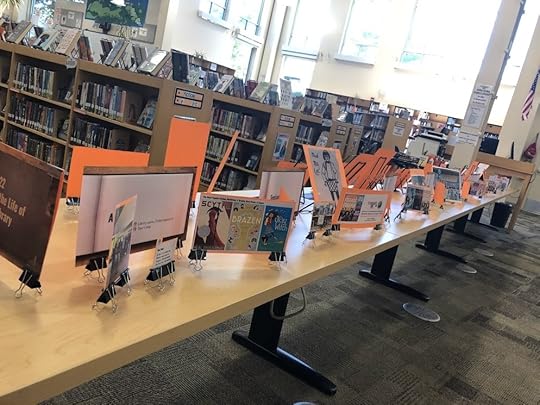 My 3-D popup scrapbook display. The front section was organized month by month with photos from library events, the most popular fiction, graphic novels, & nonfiction books from that month, and at least one weird but true thing about that month in the library. The back section of this display, where the student art and short stories were, got far and away the most attention from the students. (Photo: Shala Howell)
My 3-D popup scrapbook display. The front section was organized month by month with photos from library events, the most popular fiction, graphic novels, & nonfiction books from that month, and at least one weird but true thing about that month in the library. The back section of this display, where the student art and short stories were, got far and away the most attention from the students. (Photo: Shala Howell)The long table worked surprisingly well as a display surface. Students couldn’t help but notice it on their way to the gaming section or fiction stacks. Even better, students had plenty of room to browse the table from both sides.
Before I read De Fiallos and Cerra’s posts, I had already been considering sectioning off this long table to create five small semi-permanent, but regularly refreshed, bookstore-like table displays. I had intended to use four of them for various genres of fiction and reserve the last for “New and Noteworthy in Nonfiction.”
After reading their posts, however, I’m now thinking of pulling the table together into one coherent, but rotating display that supports events going on at the school or in the library. I’ll still have the small subsections for various genres, but instead of being completely independent, the subsections will comment on the overarching theme of the table.
For example, we run our Spooky Short Story contest every October. I’ve noticed that the quality of our short story entries go up when I use the library collection to spark ideas. Last year I did this through a bulletin board, but this year I could use the table display for it.
 My Spooky Contest bulletin board. Along the bottom were contest rules and winning entries from the previous year. Along the top I displayed bookcovers from spooky-humorous, spooky-creepy, and spooky-scary books in our collection. I find bulletin boards really challenging to design & create, though, and would love to replace them with an easier-for-me to imagine & more tangible for the students table display. (Photo: Shala Howell, Google Slides Design from SlidesCarnival)
My Spooky Contest bulletin board. Along the bottom were contest rules and winning entries from the previous year. Along the top I displayed bookcovers from spooky-humorous, spooky-creepy, and spooky-scary books in our collection. I find bulletin boards really challenging to design & create, though, and would love to replace them with an easier-for-me to imagine & more tangible for the students table display. (Photo: Shala Howell, Google Slides Design from SlidesCarnival)Three of the fiction subsections could promote spooky graphic novels, ghost stories from our short story collection, and a range of horror novels from creepy to gory to downright terrifying. The fourth section could showcase books from our nonfiction section about the craft of writing, for those students who would like tips from the pros. And that final section could include nonfiction books about the Salem Witch trials, ghost stories, and mummification, which I could bill as “background research.”
Other months could have other themes. In August, for example, the table might have small groupings of fiction, graphic novels, and nonfiction works centered on the ideas of returning to school, making new friends, and starting over in new places. I can easily imagine having a fiction section filled with books like Look Both Ways by Jason Reynolds, Not My Problem by Ciara Smyth, and Barakah Beats by Maleeha Siddiqui. A graphic novel section would be easy to fill with books like New Kid by Jerry Craft, All’s Faire in Middle School by Victoria Jamison, and Awkward by Svetlana Chmakova. Depending on what else I find in our stacks, I could have a section of sports novels centered around school teams (Dragon Hoops by Gene Luen Yang, Pippa Park Raises her Game by Erin Yun, or the Track series by Jason Reynolds). There may also be room for neurodiverse stories about navigating school and family like Fish in a Tree by Lynda Mullaly Hunt, Focused by Alison Gerber, and Tornado Brain by Cat Patrick. And of course, we have several nonfiction books in our collection about surviving middle school that the kids are likely to be most interested in at the beginning of school when they are just trying to figure things out. When she was helping me rebalance our nonfiction section, my high school age daughter somewhat grumpily pointed out that she would have totally read Luke Reynolds’ Surviving Middle School: Navigating the Halls, Riding the Social Roller Coaster, and Unmasking the Real You, if only she’d realized it existed.
This is probably old hat to you veteran librarians out there, but it’s all new and exciting to me. (New readers: this will only be my second year working in a library — Here’s what I used to do before.)
Rethinking other previously ignored flat surfacesIn Kelsey Bogan’s Dynamic Shelving post, she talks about how any flat surface is a display surface waiting to happen. It just so happens that we have a lovely set of windows in the back corner of our nonfiction section that have a line of very short bookshelves under them. You may remember them from an earlier post, when I used them to model our collection of Rubik’s Cubes.
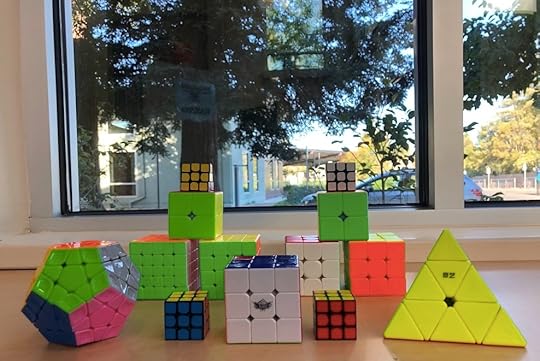 One of two low nonfiction bookcases slotted under our corner windows. (Photo: Shala Howell)
One of two low nonfiction bookcases slotted under our corner windows. (Photo: Shala Howell)Students are constantly trying to turn these bookcases into window seats, because right now, the tops of the bookcases are bare. This is a perfect place to create a second semi-permanent rotating display of nonfiction books. I could showcase at least six more books here *and* never have to ask another student to stop sitting on those particular pieces of furniture. Win-win. Even better, thanks to my student-generated list of interesting topics, it won’t take too much thought or time to pull books that my patrons are likely to be interested in.
Decorating the nonfiction section with eye-catching objects that can be seen from a distanceAs Kelsey Bogan points out in her Dynamic Shelving post, I don’t have to limit myself to decorating the library with books. She advocates for livening up the nonfiction section by decorating it with objects related to the various topics that aren’t necessarily books: stuffed animals, microscopes, and so on. The currently bare tops of our freestanding nonfiction bookcases would be a great place for this sort of stuff. They are just a little too tall to effectively display books, but might work well for related non-book objects.
When I first read Bogan’s post, I started hunting around my house for items that might work. The 3-D puzzle of Notre Dame that I did back in the summer of 2020, for example, or the steampunk-y objects my daughter made from her KiwiCo Eureka Crates. You know, the stuff that you don’t really want to keep but that it feels wrong to just take apart and throw away.
But the more I thought about it, the more I found myself reflecting on much the students enjoyed seeing each other’s art on display back in May.
This library isn’t about me or the random things I have lying around my house that happen to tie into our collection and that I’d like to find a use for. It’s about the students and what they are interested in. And it seems pretty clear to me that they are interested in each other.
What would a student-centered display look like?
At the start of the 2022-2023 school year, I could use the tops of our freestanding nonfiction bookshelves to showcase the winners of our three 2021-2022 art contests. Over time, I could easily update the display with this year’s winners.
But what I’d really like to do is ask the Art, Drama, and Career & Technical Education Teachers if I could enliven our shelves by showcasing some of their student projects. Maybe the Art Teacher would let me create a temporary display of projects from an upcoming (or recently past) student exhibition. I could ask the Drama Teacher to lend some student-made props from an upcoming (or just past) performance. The Career & Technical Education teachers must have a variety of improbably strong balsa wood bridges, electric vehicles, and student-designed robots that I could display up there, if only briefly. It’s worth a conversation, anyway.
If I could give my freestanding nonfiction stacks the reputation of being the place in the school to see what their classmates are creating in their art, drama, and technical classes… now, that would drive some traffic. And who knows, someone might just decide to check out one of our nonfiction books on drawing, crafting, computing, engineering, or acting while they are there.
That said, I am going to wait to roll this one out until later in the year, or maybe even next year. I want to assess the impact of some of the other changes on how our space feels and how the students react to it first. We have many neurodiverse students in our library and if I fill every flat surface with stuff, I may accidentally create a space that is no longer welcoming for them. They need some calm uncluttered spaces to look at too.
Other quick ideasThis post is getting pretty long, but very quickly, here are two final ideas.
1. Use looping slideshows to promote nonfiction books on display
In her post, Cerra talks about using nonfiction-centered looping slideshows to promote particularly interesting titles. I already use looping displays on the Big TV behind the circulation desk to promote new arrivals. This year I will throw in some looping slide shows to promote the nonfiction books I’ve placed on the New & Noteworthy Nonfiction section of my long table displays, the bookcases under the far window, or simply finds from the stacks on topics I know the students are interested in, like animals, coding, and chemistry.
2. Using temporarily bare shelves to host even more front-facing nonfiction books
When a teacher asks to use the library for a research project, we typically move all of the nonfiction books related to their class into the teaching area of our library. This is *great* for teaching, but it does tend to make our nonfiction section look kind of desolate. When we pull those books on space, the ancient world, or WWII, we create swathes of empty shelves in our nonfiction section. Last year, we simply put up a little sign telling folks to look for those books in the teaching area and called it a day. This year, I’d like to experiment with using those shelves as a migrating “Staff Picks in Nonfiction” display, and pull nonfiction books from other areas and showcase them face-out on the temporarily empty shelves.
So many things to try. I’m almost sad it’s still summer and I can’t do them yet.Not too sad though, because it’s really nice to sit here thinking library thoughts with this guy.
 My cat, making a persuasive argument that it’s time for me to stop typing. (Photo: Shala Howell)What about you? Librarians, what ideas do you have for boosting your nonfiction circulation? Readers, what would help make nonfiction sections feel more accessible and browse-able to you?
My cat, making a persuasive argument that it’s time for me to stop typing. (Photo: Shala Howell)What about you? Librarians, what ideas do you have for boosting your nonfiction circulation? Readers, what would help make nonfiction sections feel more accessible and browse-able to you? I would love to hear your thoughts.
Related Links: Embracing dynamic shelving (Don’t Shush Me)Rethinking Nonfiction in my School Library – With Astonishing Results by Laura Wylie De FiallosPromoting Nonfiction in a High School Library by Kerry O’Malley CerraMaking our nonfiction section more browse-able (Caterpickles)Making our nonfiction section more browse-able: Part II (Caterpickles)
July 15, 2022
Making our nonfiction section more browse-able: Part II
As I mentioned last time, my current obsession is finding ways to make our nonfiction section feel more like the nonfiction section in a bookstore, and less like an inscrutable wall of books organized by arcane numerical wizardry.
My first attempt at this involved labeling the sections of nonfiction that included books about topics that are often important to teenagers, but that they don’t always want to ask adults for help finding books about: mental illness, drug use, LGBTQ+ issues, puberty, divorce, grief, that sort of thing.
I made Life Topics lists to post on the walls and added little matching orange labels to the shelves highlighting sections that contained books about each topic.
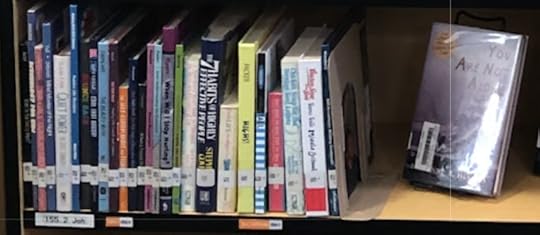 Sadly this photo is too poor a resolution for you to read them, but those orange and white shelf labels are my Life Topic labels. (Photo: Shala Howell, who probably needs a better camera)
Sadly this photo is too poor a resolution for you to read them, but those orange and white shelf labels are my Life Topic labels. (Photo: Shala Howell, who probably needs a better camera)Encouraged by the signs of new chaos in the nonfiction section generated after I posted these signs, I decided to continue experimenting with our nonfiction signage.
Our current nonfiction signs were adequate, but blandOur library uses a standard set of Dewey Decimal Explainer signs to mark where one section ends and the next begins. Each sign tells you the number of the section, its overarching subject matter, and lists five or six topics that you will find there. As far as I can tell, they are perfectly adequate and super easy to ignore.
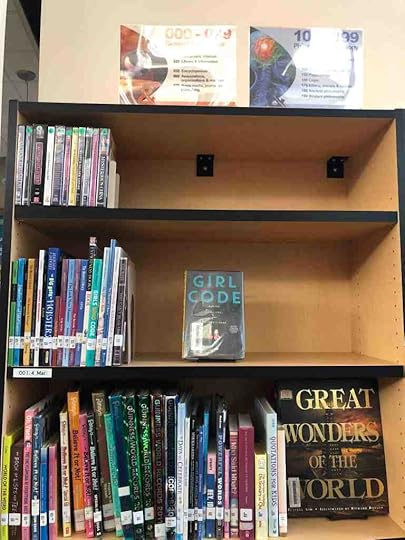 The fact that the signs are placed on top of the bookshelves behind plastic where they are subject to glare from the lights probably doesn’t help either. (Photo: Shala Howell, who continues to need a new camera).
The fact that the signs are placed on top of the bookshelves behind plastic where they are subject to glare from the lights probably doesn’t help either. (Photo: Shala Howell, who continues to need a new camera). All of the signs in our nonfiction section looked more or less like these. The colors of the CD-ROM label like art on the left changed with each section, but the general style was the same. No wonder they were exiled to the top of the bookshelves. There was little information of use on them other than the big century markings (000-099, etc.) anyway.
What if I swapped out those signs for ones that did a better job of highlighting the more interesting books in each section?During the second half of the year, I experimented with replacing some of the signs in the nonfiction section with word clouds that highlighted the more interesting topics on that bookcase. My new signs were word-heavy and needed to be placed where they could be read, so I moved them down from the top of the bookcases to live next to the books they described.
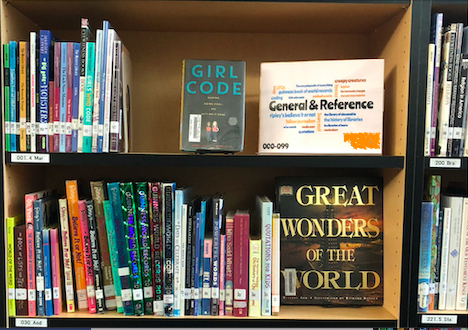 One of my experimental Word Cloud-based nonfiction signs. (Photo: Shala Howell)
One of my experimental Word Cloud-based nonfiction signs. (Photo: Shala Howell)These signs, which I generated in Google Slides using words pulled from the titles of the more interesting books included in that section of the nonfiction stacks, took forever to make.
And yes, I know that there are word-cloud generating programs available online. I tried feeding a list of titles from our nonfiction stacks into a few of them to see what would happen. I hated basically everything about the results. It was hard, if not impossible, to control which words were picked for the clouds, and the word clouds themselves looked anemic.
In the end, I decided it was better just to make the slides myself in Google Slides, so that I could control the wording, the font, the spacing, and the relative sizing to highlight topics that I was pretty sure would appeal to my patrons.
Even though I only ended up having time to make and place three or four of my new signs, I left those signs in place for the remainder of the school year to see what would happen. I did notice that books located close to one of my new signs began getting checked out.
Was the newfound popularity of our collection of books on the Salem witch trials due to my awesome new sign? Or was it the result of some student-choice research project happening that I didn’t know about? Impossible to say.
But I liked the look of the signs and the occasional sight of students reading them, so if time permits, I will make more of them to brighten up our nonfiction section next year.
In the meantime, what if I rebalanced the nonfiction section to make better use of the shelf space and give the shelves as many forward-facing books as possible?Over the year, I noticed that the forward-facing books in our fiction stacks are the books most likely to be checked out on any given day. Looking at our nonfiction stacks I noticed a few things:
Some of our shelves were completely full of densely-packed spine-out booksOther shelves were mostly or entirely empty. In nonfiction, as in fiction, the forward-facing books were most likely to be checked out.My contract with the district calls for me to work six days after school is out to prepare the library for the summer and begin making improvements for next year. I decided to use that time to rebalance the nonfiction shelves and see if I could make the section feel more browse-able and welcoming by increasing the number of forward-facing books we had on display.
To do this, I:
Measured the total available shelf spaceMeasured the empty shelf spaceDid mathMarked all of the nonfiction shelves with masking tape at the average target fullnessStarting moving books around with the goal of creating enough space on each shelf to put two books on display on each shelfRelabeled everythingMy daughter, who generously gave up her first week of summer to help me, is basically the only reason I was able to get all of this done.
 It’s a bit livelier, with those forward-facing books and alternating stacks of spine-out books, but will it be enough to get the job done? (Photo: Shala Howell)
It’s a bit livelier, with those forward-facing books and alternating stacks of spine-out books, but will it be enough to get the job done? (Photo: Shala Howell)I think it looks better. In an ideal world, I would have liked to have done a more dynamic shelving approach like this one, but we didn’t have enough display holders, bookends, or time to get it done. As it was, it took every holder, bookend, and minute we had to do this much.
Will it make a difference?Maybe?
My daughter, who redid all the labels for me, kept getting trapped by the face-out nonfiction books. So maybe?
We’ll find out in the fall.
Next week: How I’m planning to use the front half of the library to drive traffic to the back (where the nonfiction is).In the meantime, my cat would very much like me to know that it’s time to have a snack.
 My cat thinking deep thoughts about how to get me to stop typing and start dishing out the tuna. (Photo: Shala Howell)What about you? Librarians, what ideas do you have for boosting your nonfiction circulation? Readers, what would help make nonfiction sections feel more accessible and browse-able to you?
My cat thinking deep thoughts about how to get me to stop typing and start dishing out the tuna. (Photo: Shala Howell)What about you? Librarians, what ideas do you have for boosting your nonfiction circulation? Readers, what would help make nonfiction sections feel more accessible and browse-able to you? I would love to hear your thoughts.
Related Links: Embracing dynamic shelving (Don’t Shush Me)Making our nonfiction section more browse-able (Caterpickles)



